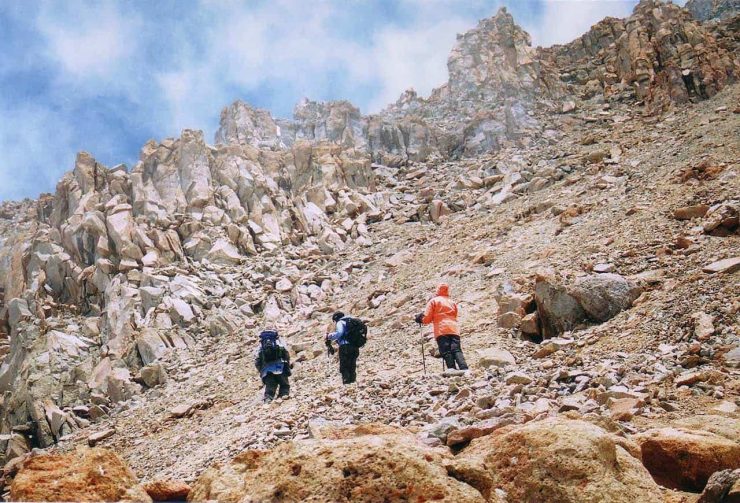Climbing Kilimanjaro via the Western Breach route offers the most challenging endeavor for mountaineers. This path is not only demanding but also the riskiest way to ascend Kibo and make it to Uhuru Peak.
The peril isn’t inherently in the trek itself. Rather, the danger stems from the receding glaciers above the route. As these glaciers melt and retreat, they unleash rocks that were previously held in place. This makes the Western Breach a daunting choice, demanding both skill and caution from those who opt to take it.
The Western Breach Route on Mount Kilimanjaro: A Look Back at the 2006 Tragedy
In January 2006, a tragic rockfall incident on the Western Breach Route claimed the lives of three American climbers.
The Western Breach Kilimanjaro Tragedy of 2006
Following this unfortunate event, the route was temporarily shut down to facilitate a thorough investigation. The findings of this probe indicated clear dangers on the route. Rockslides were not an isolated event, and the possibility of future incidents was evident. In response to these concerns, alterations were made to the route in an effort to minimize the duration climbers spent in the most vulnerable zones.
Despite the recognized risks, the Western Breach Route was reopened after some time. Numerous agencies continue to offer climbs via this path, catering to those adventurers who are drawn to the allure of tackling Kilimanjaro’s most challenging ascent. For some, the thrill of conquering the mountain’s most daunting route is an irresistible siren call.
The Allure of the Western Breach Route on Mount Kilimanjaro
What makes the Western Breach Route so enticing to climbers?
- The Challenge and Uniqueness: At its core, many adventurers are drawn to the sheer challenge presented by the Western Breach Route. It offers the opportunity to undertake an unusual endeavor, setting oneself apart from the majority. The path less traveled, as they say, always has its unique allure.
- The Crater Experience: As its name implies, this route provides passage through a breach in the crater wall. While most other Kilimanjaro routes culminate at the crater’s edge, the Western Breach immerses climbers within the very heart of the mountain. This provides an unmatched experience, allowing climbers to literally step inside the mountain’s crater.
- Exploration Opportunities: The route offers climbers the rare opportunity to set camp within the crater, an experience that few other routes provide. From here, climbers can set out to explore iconic landmarks including the Furtwangler Glacier, the Ernst Reusch Crater, and the Ash Pit. Additionally, those with the time and energy can even venture to the Northern and Eastern Ice Fields.
In essence, the Western Breach Route is not just about summiting Kilimanjaro; it’s about immersing oneself in the very anatomy of the mountain, providing a more intimate and unparalleled adventure.
 While the allure of the Kilimanjaro climb via the Western Breach Route is tempting, the associated risks might make you reconsider. Thankfully, there are ways to experience the crater and breach from a safer vantage point.
While the allure of the Kilimanjaro climb via the Western Breach Route is tempting, the associated risks might make you reconsider. Thankfully, there are ways to experience the crater and breach from a safer vantage point.
Though descending into the crater isn’t a standard feature of most Kilimanjaro routes, it can be incorporated into any of them. Various agencies even present the option to spend a night in the crater camp. Securing this experience should be straightforward if you opt for a private climb.
In theory, you might think about adding a brief crater visit during your summit day, descending into the crater and then ascending back. This might add approximately two hours to your journey, offering a unique opportunity to explore. But, in practice, the physical demands might be overwhelming. By the time you reach the summit, the energy and desire might be lacking. If you genuinely wish to witness the beauty of the crater, it’s advised to allocate a night for the experience. Furthermore, prioritize ample time for acclimatization en route; the elevation of 5729 m (18,796 ft) demands it a safe and comfortable stay.
The Western Breach route of Kilimanjaro has seen multiple accidents, but one stands out as the most heart-wrenching:
On January 4, 2006, a team of American trekkers was en route from the Arrow Glacier Camp towards the Western Breach. They had barely left the camp when a massive rock release occurred 150 meters above them, discharging roughly 39 tonnes of rock. The strong winds that day likely masked the sound of the impending rockfall until it was too late.
Tragically, three trekkers lost their lives, with another and four porters suffering severe injuries. Subsequent investigations established that the rockfall was a consequence of the glacier’s melting and retreat. This melting released rocks that had previously been trapped in the ice. While occasionally only single rocks tumble down, this instance saw an entire deposit give way.
As the glacier continues to melt and recede, the potential for further rockfalls remains. While predicting the exact timing of these events is challenging, the areas of probable impact can be determined. The investigative team identified a particularly high-risk region, ominously termed the “death zone.”
This perilous area is unavoidable. However, the tragedy led to changes in the route to reduce exposure to this zone. The original path that the American climbers and all previous Western Breach trekkers had used required nearly an hour’s traversal of this risky territory. The modified route cut this time to a mere five minutes.
